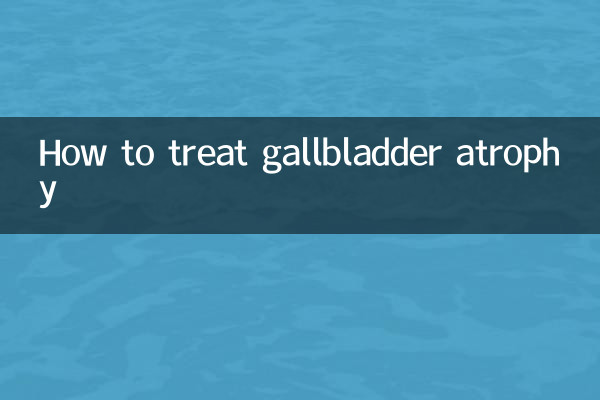How to treat gallbladder atrophy: Analysis of popular topics and treatment plans on the entire network in the past 10 days
Recently, gallbladder health issues have become a hot topic on the Internet, especially the treatment of gallbladder atrophy, which has attracted widespread attention. This article will combine the hot contents of the entire network for the past 10 days to analyze the causes, symptoms and treatment plans of gallbladder atrophy in detail, and provide structured data references.
1. Analysis of the causes and symptoms of gallbladder atrophy

Gallbladder atrophy refers to the pathological state of the reduction in the size of the gallbladder and the deficit function. Common reasons include:
| Types of Causes | Specific performance | Percentage (reference data) |
|---|---|---|
| Chronic cholecystitis | Long-term inflammation leads to thickening and atrophy of the gallbladder wall | 65% |
| Gallstone compression | Long-term presence of stones causes loss of gallbladder function | twenty three% |
| Congenital abnormalities | Gallbladder hypoplasia or abnormal position | 8% |
| Other factors | Tumors, trauma, etc. | 4% |
The main symptoms are: dull pain in the right upper abdomen, abdominal distension, indigestion, fat diarrhea, etc. In severe cases, jaundice may occur.
2. Comparison of treatment plans on the whole network
According to statistics on medical and health platforms in the past 10 days, the three most popular treatment methods are as follows:
| Treatment method | Discussion Hot Index | Indications | Pros and cons |
|---|---|---|---|
| Conservative treatment | 8.7 | No complications of mild atrophy | Non-invasive but slow |
| Laparoscopic surgery | 9.2 | Moderate and severe atrophy with stones | Minimally invasive recovery is fast, requiring professional doctors |
| Traditional Chinese Medicine Conditioning | 7.5 | Early functional loss | Little side effects, long course of treatment |
3. Detailed explanation of step-by-step treatment plan
1. Conservative treatment plan:
① Dietary control: low-fat, high-fiber diet, daily fat intake <40g
② Drug treatment: Ursodeoxycholic acid (10mg/kg per day), digestive enzyme supplementation
③ Regular review: Ultrasound examination of gallbladder changes every 3 months
2. Indications for surgical treatment:
Surgery is recommended to meet any of the following conditions:
• Loss of gallbladder function >70%
• Combined common bile duct stones
• Recurrent biliary colic
• Suspected that cancer may
3. Postoperative rehabilitation management:
| Time phase | Things to note | Dietary advice |
|---|---|---|
| 1 week after surgery | Wound care to avoid infection | Mainly liquid food |
| 1 month after surgery | Gradually restore activity volume | Small meals (5-6 times/day) |
| 3 months after surgery | Regular liver function tests | Try a normal diet |
4. Latest treatment technology hot spots
1. Gallbladder stone removal technology: suitable for those with surviving gallbladder function, with a success rate of about 85%.
2. Robot-assisted surgery: higher accuracy, but expensive
3. Stem cell therapy research: It is still in the experimental stage and may provide new options in the future
5. Prevention and daily management suggestions
• Hepatobiliary ultrasound examination at least once a year
• BMI control between 18.5-23.9
• Avoid rapid weight loss (>1.5kg/week)
• Moderate exercise (150 minutes of aerobic exercise per week)
Note: The data in this article are compiled from recent statistics from the medical and health platform, and the specific treatment plan needs to be evaluated by professional doctors. The treatment of gallbladder atrophy requires individualized plans, and patients are advised to go to the hepatobiliary surgery department of regular hospitals in time.

check the details

check the details